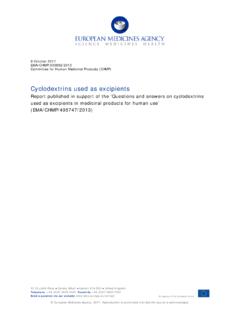Transcription of Techniques to improve the solubility of poorly soluble drugs
1 Review Article [Modasiya et al., 3(2): Feb., 2012] ISSN: 0976-7126 Int. J. of Pharm. & Life Sci. (IJPLS), Vol. 3, Issue 2: Feb.: 2012, 1459-1469 1459 INTERNATIONAL JOURNAL OF PHARMACY & LIFE SCIENCES Techniques to improve the solubility of poorly soluble drugs Jinal N. Patel1*, Dharmendra M. Rathod1, Nirav A. Patel2 and Moin K. Modasiya1 1, APMC College of Pharmaceutical Education and Research, Himatnagar, (Gujarat) - India 2, Naratha Mandal College of Pharmacy, Belgaum, (Karnataka) - India Abstract A drug administered in solution form immediately available for absorption and efficiently absorbed than the same amount of drug administered in a tablet or capsule form.
2 solubility is a most important parameter for the oral bioavailability of poorly soluble drugs . Dissolution of drug is the rate determining step for oral absorption of the poorly water soluble drugs , which can subsequently affect the in vivo absorption of drug. Currently only 8% of new drug candidates have both high solubility and permeability. Because of solubility problem of many drugs the bioavailability of them gets affected and hence solubility enhancement becomes necessary. It is now possible that to increase the solubility of poorly soluble drugs with the help of various Techniques such as Physical method, Chemical method.
3 Co-crystallisation, co-solvency solubilizing agents, molecular encapsulation with cyclodextrins, nanotechnology approaches and hydrotropy. Key-Words: solubility , Dissolution and Bioavailability Introduction Therapeutic effectiveness of a drug depends upon the bioavailability and ultimately upon the solubility of drug molecules. solubility is one of the important parameter to achieve desired concentration of drug in systemic circulation for pharmacological response to be shown.
4 Currently only 8% of new drug candidates have both high solubility and permeability [1]. The solubility of a solute is the maximum quantity of solute that can dissolve in a certain quantity of solvent or quantity of solution at a specified temperature [2]. In the other words the solubility can also define as the ability of one substance to form a solution with another substance [3]. The substance to be dissolved is called as solute and the dissolving fluid in which the solute dissolve is called as solvent, which together form a solution.
5 The process of dissolving solute into solvent is called as solution or hydration if the solvent is water [4]. * Corresponding Author E-Mail: Process of solubilisation [3] The process of solubilisation involves the breaking of inter-ionic or intermolecular bonds in the solute, the separation of the molecules of the solvent to provide space in the solvent for the solute, interaction between the solvent and the solute molecule or ion. When Solubilisation process occur break down of solute bond occurs and holes can be seen as shown in Figure 1.
6 When solubilisation process occur solid molecules break down because of breaking of inter molecular bonding shown in Figure freed solid molecule is integrated in the solvent shown in Figure 3. Fig. 1: Holes opens in the solvent Fig. 2: Molecules of the solid breaks away from the bulk Review Article [Modasiya et al., 3(2): Feb., 2012] ISSN: 0976-7126 Int. J. of Pharm. & Life Sci. (IJPLS), Vol. 3, Issue 2: Feb.
7 : 2012, 1459-1469 1460 Fig. 3: The freed solid molecule is integrated into the hole in the solvent. Factors affecting solubility The solubility depends on the physical form of the solid, the nature and composition of solvent medium as well as temperature and pressure of system [6]. Particle size The size of the solid particle influences the solubility because as a particle becomes smaller, the surface area to volume ratio increases. The larger surface area allows a greater interaction with the solvent. The effect of particle size on solubility can be explained as per the following equation.
8 [3] Where, S is the solubility of infinitely large particles, S is the solubility of fine particles, V is molar volume , G is the surface tension of the solid, R is the radius of the fine particle Temperature Temperature will affect solubility . If the solution process absorbs energy then the solubility will be increased as the temperature is increased. If the solution process releases energy then the solubility will decrease with increasing temperature [7]. Generally, an increase in the temperature of the solution increases the solubility of a solid solute.
9 A few solid solutes are less soluble in warm solutions. For all gases, solubility decreases as the temperature of the solution increases [2]. Pressure For gaseous solutes, an increase in pressure increases solubility and a decrease in pressure decrease the solubility . For solids and liquid solutes, changes in pressure have practically no effect on solubility [2]. Nature of the solute and solvent While only 1 gram of lead (II) chloride can be dissolved in 100 grams of water at room temperature, 200 grams of zinc chloride can be dissolved.
10 The great difference in the solubilities of these two substances is the result of differences in their nature [2]. Molecular size The larger the molecule or the higher its molecular weight the less soluble the substance. Larger molecules are more difficult to surround with solvent molecules in order to solvate the substance. In the case of organic compounds the amount of carbon branching will increase the solubility since more branching will reduce the size (or volume) of the molecule and make it easier to solvate the molecules with solvent [7].





